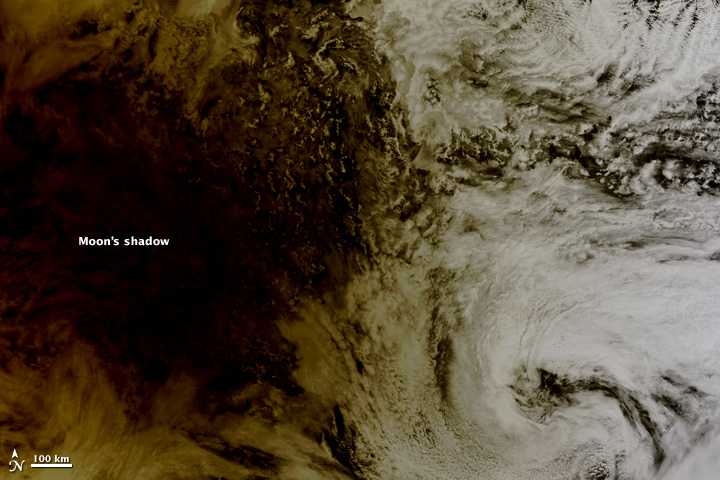File:Annular Eclipse over the Pacific Ocean - NASA Earth Observatory.jpg
Annular_Eclipse_over_the_Pacific_Ocean_-_NASA_Earth_Observatory.jpg (720 × 480 pixels, file size: 155 KB, MIME type: image/jpeg)
Captions
Captions
Summary[edit]
| DescriptionAnnular Eclipse over the Pacific Ocean - NASA Earth Observatory.jpg |
To download the full resolution and other files go to: earthobservatory.nasa.gov/IOTD/view.php?id=78024&src=... On May 20, 2012, sky watchers from eastern Eurasia to western North America saw a fiery ring around the Moon as it passed between the Sun and the Earth. Known as an annular eclipse, the event blocked sunlight across a swath of Earth up to 300 kilometers (185 miles) wide, and the effects were most dramatic across the northern Pacific Ocean. As people on the ground looked up at the sky and saw a ring, the Moderate Resolution Imaging Spectroradiometer (MODIS) looked down and saw the Moon’s shadow racing eastward over Earth’s surface. The MODIS instrument on NASA’s Terra satellite captured this natural-color image of the shadow on the Pacific Ocean at roughly 11:30 a.m. local time on May 21 (23:30 Universal Time on May 20). Where the Moon passed in front of the Sun, Earth’s surface appeared black (left half of image). Around the margins of the shadow, our planet’s surface appeared yellowish brown. The shadow cast by an eclipse consists of two parts, the completely shadowed umbra and the partially shadowed penumbra. The annular eclipse started in southern China at 22:06 UTC on May 20. It then passed over the southern coast of Japan, and swept over the Pacific Ocean south of Alaska’s Aleutian Islands. The eclipse finished over Oregon and California around 01:30 UTC on May 21, having crossed the international date line. The eclipse reached its maximum duration of 5 minutes 46 seconds over the Pacific Ocean. During this eclipse, the Moon’s apparent diameter was 94 percent of the Sun’s, showing viewers on the ground a bright ring of light. Whether they could see the full eclipse or just a partial eclipse, millions of people turned out to see the show and many posted their photos online. NASA image by Jeff Schmaltz, LANCE MODIS Rapid Response. Caption by Michon Scott. The Earth Observatory's mission is to share with the public the images, stories, and discoveries about climate and the environment that emerge from NASA research, including its satellite missions, in-the-field research, and climate models. Like us on Facebook Follow us on Twitter Add us to your circles on Google+ |
| Date | |
| Source | Annular Eclipse over the Pacific Ocean |
| Author | NASA's Earth Observatory |
Licensing[edit]
- You are free:
- to share – to copy, distribute and transmit the work
- to remix – to adapt the work
- Under the following conditions:
- attribution – You must give appropriate credit, provide a link to the license, and indicate if changes were made. You may do so in any reasonable manner, but not in any way that suggests the licensor endorses you or your use.
| This image was originally posted to Flickr by NASA Earth Observatory at https://www.flickr.com/photos/68824346@N02/7249274636. It was reviewed on 2 July 2012 by FlickreviewR and was confirmed to be licensed under the terms of the cc-by-2.0. |
2 July 2012
File history
Click on a date/time to view the file as it appeared at that time.
| Date/Time | Thumbnail | Dimensions | User | Comment | |
|---|---|---|---|---|---|
| current | 17:02, 2 July 2012 |  | 720 × 480 (155 KB) | Dzlinker (talk | contribs) | == {{int:filedesc}} == {{Information |Description=To download the full resolution and other files go to: [http://earthobservatory.nasa.gov/IOTD/view.php?id=78024&src=flickr earthobservatory.nasa.gov/IOTD/view.php?id=78024&src=...] On May 20, 2012, sky... |
You cannot overwrite this file.
File usage on Commons
The following page uses this file:
- File:Annular Eclipse over the Pacific Ocean, May 20 2012.PNG (file redirect)
File usage on other wikis
The following other wikis use this file:
- Usage on es.wikipedia.org
- Usage on gl.wikipedia.org
Metadata
This file contains additional information such as Exif metadata which may have been added by the digital camera, scanner, or software program used to create or digitize it. If the file has been modified from its original state, some details such as the timestamp may not fully reflect those of the original file. The timestamp is only as accurate as the clock in the camera, and it may be completely wrong.
| Unique ID of original document | xmp.did:0E5ADA2309206811AA83DDB2DE9A5ECB |
|---|---|
| Software used | Adobe Photoshop CS5 Macintosh |
